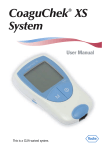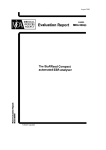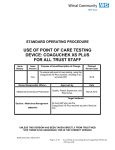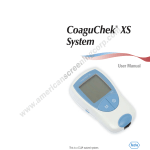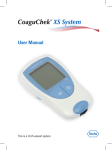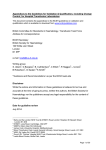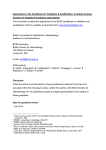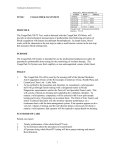Download COAGUCHEK XS Plus MONITOR
Transcript
Luton & Dunstable Hospital NHS Foundation Trust LP-HAE-COAGCHXS Department of Haematology and Blood Transfusion Edition 1.0 Date of Issue 14/03/08 Page 1 of 1 PRINTED COPIES UNCONTROLLED UNLESS MARKED ‘CONTROLLED’ IN RED COAGUCHEK XS Plus MONITOR INDEX CODE LP-HAE-COAGCHXS EDITION No 1.0 DATE OF ISSUE 14th March 2008 REVIEW INTERVAL 2 Years AUTHORISED BY Dr D S Thompson AUTHOR D K Mills COPY of 2 LOCATION OF COPIES 1. Haematology Master File 2. Anticoagulant Clinic Electronic Archive Document review history Review date Reviewed by Signature C:\DOCUME~1\dmills\LOCALS~1\Temp\0dbc5edc-1524-4af9-bf21-5f4b4be4db52\Coaguchek XS Plus.doc Title Coaguchek XS Plus Monitor Author D K Mills Authorised by Dr D S Thompson Luton & Dunstable Hospital NHS Foundation Trust LP-HAE-COAGCHXS Department of Haematology and Blood Transfusion Edition 1.0 Date of Issue 14/03/08 Page 2 of 2 PRINTED COPIES UNCONTROLLED UNLESS MARKED ‘CONTROLLED’ IN RED DOCUMENT AMENDMENT FORM Document Title CoaguChek XS Plus Monitor Record Filename LP-HAE-COAGCHXS Page Number Amendment Number Date Authorised by 1 2 3 4 5 6 7 8 9 10 The amendment must be authorised by a BMS2 or above AND a Quality Manager to ensure all copies including the electronic version are updated simultaneously. Any minor amendment must be handwritten without obscuring the previous text. An asterisk is written in the adjacent margin to highlight the alteration and is signed and dated by a BMS2 or above. Amendments requiring immediate action must be handwritten without obscuring the previous text. An asterisk is written in the adjacent margin to highlight the alteration and is signed and dated by a BMS2 or above. Ten or less minor amendments may be recorded before a new edition is issued. Major changes must result in the immediate review of the procedure. Document amendment does not replace the document review process. C:\DOCUME~1\dmills\LOCALS~1\Temp\0dbc5edc-1524-4af9-bf21-5f4b4be4db52\Coaguchek XS Plus.doc Title Coaguchek XS Plus Monitor Author D K Mills Authorised by Dr D S Thompson Luton & Dunstable Hospital NHS Foundation Trust LP-HAE-COAGCHXS Department of Haematology and Blood Transfusion Edition 1.0 Date of Issue 14/03/08 Page 3 of 3 PRINTED COPIES UNCONTROLLED UNLESS MARKED ‘CONTROLLED’ IN RED • CLINICAL RELEVANCE / PURPOSE The CoaguChek XS Plus system (monitor, controls and test strips) quantitatively determines prothrombin time (PT / INR) using capillary blood from a fingertip or venous (nonanticoagulated) whole blood. • PRINCIPLE The CoaguChek test strip contains a lyophilised reagent, the reactive components of which are thromboplastin and a peptide substrate. When a sample is applied, thromboplastin activates coagulation, leading to the formation of thrombin. The enzyme thrombin cleaves the substrate generating an electrochemical signal. The elapsed time from application of the sample to reaction completion is converted by an algorithm into the customary INR value and displayed. This is dependant on the values on the code chip supplied with each batch of test strips. For detailed operating instructions, refer to the user manual with the instrument. • RELATED DOCUMENTS Clinical guidelines for implementing patient self testing and self management of oral anticoagulation. Coaguchek XS Plus operators manual • PRECAUTIONS Biological specimens may present a risk of infection. Avoid testing in bright, direct sunlight. Only use the monitor at room temperature between 18 and 32oC Any unexpected or adverse incidents occurring during this procedure should be reported to a senior member of staff who will decide whether further action is required. Refer to the Hospital Policy for Adverse Incident Reporting. • SPECIMENS Capillary whole blood or (non-anticoagulated) venous whole blood. At least 25µl. C:\DOCUME~1\dmills\LOCALS~1\Temp\0dbc5edc-1524-4af9-bf21-5f4b4be4db52\Coaguchek XS Plus.doc Title Coaguchek XS Plus Monitor Author D K Mills Authorised by Dr D S Thompson Luton & Dunstable Hospital NHS Foundation Trust LP-HAE-COAGCHXS Department of Haematology and Blood Transfusion Edition 1.0 Date of Issue 14/03/08 Page 4 of 4 PRINTED COPIES UNCONTROLLED UNLESS MARKED ‘CONTROLLED’ IN RED • EQUIPMENT & REAGENTS CoaguChek XS Plus Monitor Code chip Test strip Lancet Cotton swab or tissue plus : CoaguChek Quality control Pack contains 4 bottles of freeze dried control 4 pipettes of reagent QC Code chip for patient samples for Q.C. testing Record all reagent batch numbers in instrument log. • QUALITY ASSURANCE The Coaguchek XS plus system has a number of inbuilt QC functions: A check of the electronic components and functions every time the monitor is turned on. A check on the test strip temperature whilst the test is in process. A check on the expiry date and lot information on the test strip, carried out by the code chip. A quality control function ic incorporated into the test strip. NEQAS samples are to be performed (every 2 months) as and when they arrive, in liaison with the Senior BMS in Haematology. At least once a month perform a control sample, or when a new batch of test strips is used. 1. When a new QC pack is opened, the code chip from the box must be placed into the monitor prior to performing the first test on that batch of QC reagents. 2. Open one of the control vials. Taking one of the pipettes, hold it upside down, so that the liquid falls into the bulb and break off the end. 3. Add the contents of the pipette to the control vial and mix gently by swirling. Do not shake. Reagent is stable for 30 minutes once reconstituted. 4. From the main menu on the monitor, select QC option and select code chip displayed, ensuring it is the correct one for the QC batch. 5. Insert test strip and allow to warm. 6. Use the pipette again to suck up the control liquid. Discard the first drop and apply the second drop to the test strip. 7. Result displays when testing is complete, with INR and range for the relevant code chip. 8. Results are stored in memory and can be accessed from main menu C:\DOCUME~1\dmills\LOCALS~1\Temp\0dbc5edc-1524-4af9-bf21-5f4b4be4db52\Coaguchek XS Plus.doc Title Coaguchek XS Plus Monitor Author D K Mills Authorised by Dr D S Thompson Luton & Dunstable Hospital NHS Foundation Trust LP-HAE-COAGCHXS Department of Haematology and Blood Transfusion Edition 1.0 Date of Issue 14/03/08 Page 5 of 5 PRINTED COPIES UNCONTROLLED UNLESS MARKED ‘CONTROLLED’ IN RED Record all control results in the instrument log If result is outside range : retest with a new strip and control, Ensure control is properly mixed Check storage and expiry dates Clean monitor and guides if necessary. If still out of range, return monitor to haematology for checking. Do not use for patients until told by Laboratory staff that it is safe to use. • CLEANING Turn instrument off before cleaning. Only use alcohol free cleaning materials. Refer to user manual for detailed instructions • METHOD Code chip replacement NB. The code chip contains the programming information about the test type, lot number and expiration date. A new code chip can be found with each test kit and must be used only with the test strips in that kit. If opening a fresh batch of test strips, replace the old code chip with the new chip in the test kit. a) Turn the monitor off before removing the old code chip. b) Remove and discard the old chip. c) Insert the new chip until it snaps into place. Make sure the number on the code chip matches the last three numbers on the test strip pouch and that it is inserted number side up. d) Even if the code chip is removed from the instrument (after a test has been performed), it will retain the details and continue to use the data for the remainder of the test strips, or until a new code chip has been inserted and a test performed. Capillary blood testing 1. Test strips can be kept with the instrument (no longer refrigerated) and are stable for 10 minutes when removed from the container. Store remainder in the air tight container. Ensure the code number on the display matches the code number of the test strip you are using. Prepare lancet and swab and set aside until needed. 2. Switch on the monitor, and from the main menu, select patient test. 3. Enter ID if required or just press √. 4. Monitor will request a test strip, insert it into the monitor, printed side up. Push in until it stops. The strip icon on the display appears and the clock flashes. The monitor will warm the strip for about 45 seconds. C:\DOCUME~1\dmills\LOCALS~1\Temp\0dbc5edc-1524-4af9-bf21-5f4b4be4db52\Coaguchek XS Plus.doc Title Coaguchek XS Plus Monitor Author D K Mills Authorised by Dr D S Thompson Luton & Dunstable Hospital NHS Foundation Trust LP-HAE-COAGCHXS Department of Haematology and Blood Transfusion Edition 1.0 Date of Issue 14/03/08 Page 6 of 6 PRINTED COPIES UNCONTROLLED UNLESS MARKED ‘CONTROLLED’ IN RED 5. When the monitor displays a countdown (from 120 secs), Prick the patient's fingertip with a lancet and gently squeeze finger to produce a large (hanging) drop. Using the first drop from the finger, apply the drop directly from the finger to the dark line on the test strip, and hold in place until the monitor beeps (sufficient blood). The monitor does not need to be kept still and can be moved to the patient to allow easy sampling of blood. 6. The monitor will beep again when the test is complete and the result is displayed. Remove the used test strip from the instrument and discard. Test strips have an in-built QC that validates the patient test. Failure to pass this QC will invalidate the test and no result will be displayed. 7. If finished testing, switch off the monitor and clean if necessary (see user manual for details). • RESULTS The monitor will display the result as an INR. Record the value in the patient's record / notes and also on the result sheet provided. All samples with an INR >8.0 are above the instrument's testing range and must be checked by a venous sample sent to the Haematology department. If the monitor prompts INR>8.0 or INR < 0.8, the result is outside the measurable range, remove the test strip and repeat with a new one. If still the same, check the result by a venous sample sent to Haematology. Results are stored in the instrument memory, latest result first. It stores patient ID (if entered) with date and time, code chip and strip numbers. Access them from main menu & memory. C:\DOCUME~1\dmills\LOCALS~1\Temp\0dbc5edc-1524-4af9-bf21-5f4b4be4db52\Coaguchek XS Plus.doc Title Coaguchek XS Plus Monitor Author D K Mills Authorised by Dr D S Thompson Luton & Dunstable Hospital NHS Foundation Trust LP-HAE-COAGCHXS Department of Haematology and Blood Transfusion Edition 1.0 Date of Issue 14/03/08 Page 7 of 7 PRINTED COPIES UNCONTROLLED UNLESS MARKED ‘CONTROLLED’ IN RED DECLARATION I have read and been trained in the (Standard Operating) Procedure for Coaguchek XS Plus Monitor and agree to comply. PRINT NAME SIGNATURE DATE C:\DOCUME~1\dmills\LOCALS~1\Temp\0dbc5edc-1524-4af9-bf21-5f4b4be4db52\Coaguchek XS Plus.doc Title Coaguchek XS Plus Monitor Author D K Mills Authorised by Dr D S Thompson









